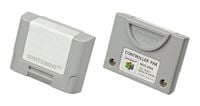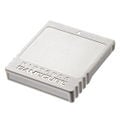Memory Card
This article is currently being considered for deletion.
If you do not feel this page should be deleted, please explain on its talk page.
A Memory Card is a video game accessory that has been a part of many gaming consoles. Essentially, it is an external memory database where game data is saved, including for games of the Super Mario franchise. From Nintendo 64 to Nintendo 3DS, a non-standard measurement unit called a block (a page on Nintendo 64) was used for memory card capacity by Nintendo and in the consoles' system settings, and the size of the unit increased between console generations, though consistently became 128 KB in size throughout the Wii, Nintendo DSi and Nintendo 3DS.[1]. Since the Wii U, industry standard units like gigabytes and megabytes are used within the consoles' settings.
List of Memory cards[edit]
Controller Pak[edit]

The Controller Pak is an accessory for the Nintendo 64 and the first memory card for a Nintendo console. It plugs into the controller's accessory slot. Many games just use the Controller Pak for storing non-main game data, mainly since cartridges allow for data to be saved directly onto them. One Super Mario game to utilize this is Mario Kart 64, where all race data is saved onto the game, but Ghosts from time trials are saved onto the Controller Pak, where they take up either 121 (30.9 KB) or 123 (31.4 KB) blocks.
Most Controller Paks can only hold up to 123 pages (31.4 KB) of memory, and have 128 pages total (one page being 256 bytes), with the remaining 5 pages (1.2 KB) reserved for formatting purposes.[citation needed]
Nintendo GameCube[edit]

Unlike the Nintendo 64, the Nintendo GameCube is very dependent on the memory card, since save data cannot be written on its discs, and the GameCube lacks any form of internal memory. Games played without the memory card inserted act as if they were being played for the first time, and data cannot be saved. Three types of memory cards were officially released, from lowest to highest storage and sporting color differentiation: the first type is gray and can store up to fifty-nine blocks (0.47 MB); the second is black and can store up to 251 (2.0 MB); and the third is white and can store up to 1,019 (8.1 MB). Nintendo of Europe lists the rate for GameCube memory cards as 59 blocks (4 MB),[2] which would result in 66-70 KB per block; other sources contradict this, indicating that Nintendo of Europe mistakenly measured in megabytes instead of megabits, instead resulting in 7-8 KB per block.
Below is a list of the different Super Mario games and their respective block size, and conversion to kilobytes.
| Game | Blocks | Kilobytes (KB) |
|---|---|---|
| Super Mario Sunshine | 7 | 56 |
| WarioWare, Inc.: Mega Party Game$! | 4 | 32 |
| Mario Party 6 | 5 | 40 |
| Mario Kart: Double Dash!! | 8 | 64 |
| Mario Kart: Double Dash!! (each Time Trial ghost) | 5 | 40 |
| Super Mario Strikers | 5 | 40 |
| Paper Mario: The Thousand-Year Door | 17 | 136 |
| Mario Party 7 | 6 | 48 |
| Mario Power Tennis | 3 | 24 |
| Mario Golf: Toadstool Tour | 13 | 104 |
| Donkey Konga 3 JP | 5 | 40 |
| Wario World | 10 | 80 |
| Nintendo Puzzle Collection | 6 | 48 |
| Mario Party 4 | 2 | 16 |
| Mario Party 5 | 5 | 40 |
| Luigi's Mansion | 3 | 24 |
| Dance Dance Revolution: Mario Mix | 2 | 16 |
| Mario Superstar Baseball | 10 | 80 |
| Donkey Kong Jungle Beat | 3 | 24 |
| SSX on Tour | 59[3] | 472 |
| NBA Street V3 | 15 | 120 |
SD cards[edit]
It has been requested that this section be rewritten and expanded to include more information. Reason: The section contradicts itself on whether pre-Switch consoles could handle more than 32 GB, e.g. 64 GB. (tagged on May 4, 2024)
SD cards are very common types of storage mediums that Nintendo began using since the Wii era. The Wii, unlike the Nintendo GameCube, has internal memory where players can save their game data, or even on SD cards, especially in cases where the internal memory runs out of storage. SD cards can store the Wii's channel data and some non-save game data, such as snapshots in Super Smash Bros. Brawl, though the game also allows snapshots to be saved on the internal storage. The Wii, Nintendo 3DS, and Wii U all support SD cards up to 32GB in memory, though in the Wii's case, before the System Menu 4.0 update in March 2009, it could support only up to 2GB standard SD cards, not any SDHC cards. Super Smash Bros. Brawl and many other games are incompatible with SDHC cards, especially if they were released before the Wii gained SDHC card support.
The Wii has an SD card button in the lower left corner of the Wii Menu. If the button shows up as blue instead of gray, meaning the Wii acknowledges that an SD card is inserted, clicking on the button will show a special menu with gray boxes on black, showing Virtual Console and WiiWare games that are stored on the SD card, including any of Super Mario franchise.
The Nintendo Switch uses MicroSD cards for internal storage, allowing for up to 2 TB. Two official Nintendo microSD cards designed especially for the Nintendo Switch are Super Mario-themed: the red 128GB microSD card with a Mushroom and the yellow 512GB microSD card with a Super Star symbol.
| Game | Blocks | Kilobytes (KB) |
|---|---|---|
| Super Mario Galaxy | 1 | 128 |
| Super Mario Galaxy 2 | 1 | 128 |
| New Super Mario Bros. Wii | 1 | 128 |
| Super Paper Mario | 1 | 128 |
| Super Mario All-Stars Limited Edition | 1 | 128 |
| Mario Strikers Charged | 1 | 128 |
| Super Mario Sluggers | 2 | 256 |
| Mario Power Tennis | 1 | 128 |
| Mario Party 8 | 1 | 128 |
| Mario Party 9 | 1 | 128 |
| Super Smash Bros. Brawl (each custom stage or replay) | 1 | 128 |
| Donkey Kong Country Returns | 2 | 256 |
Channel and WiiWare game sizes[edit]
For Wii channels and WiiWare games that can be copied in their entirety normally to an SD card in the Data Management settings.
| Game | Blocks | Megabytes (MB) |
|---|---|---|
| Mario Kart Channel | 86 | 11.0 |
| Dr. Mario Online Rx | 83 | 10.6 |
| WarioWare: D.I.Y. Showcase | 86 | 11.0 |
SD card support table[edit]
| Wii | Wii U | Nintendo DSi | Nintendo 3DS | New Nintendo 3DS | Nintendo Switch | |
|---|---|---|---|---|---|---|
| SD | ||||||
| SDHC | ||||||
| SDXC |
1 - Needs to be on Wii System Menu 4.0 or higher. Most older games are incompatible.
2 - The SDXC card has to be formatted to FAT32 with 32k clusters.
3 - MicroSD only
References[edit]
- ^ How to Check Available Blocks of Memory on the Wii. Nintendo of America.
- ^ Memory Card 59. Nintendo of Europe. Retrieved May 9, 2024.
- ^ The PAL and JP releases instead state 7 blocks. The reason for this discrepancy is not yet known.
